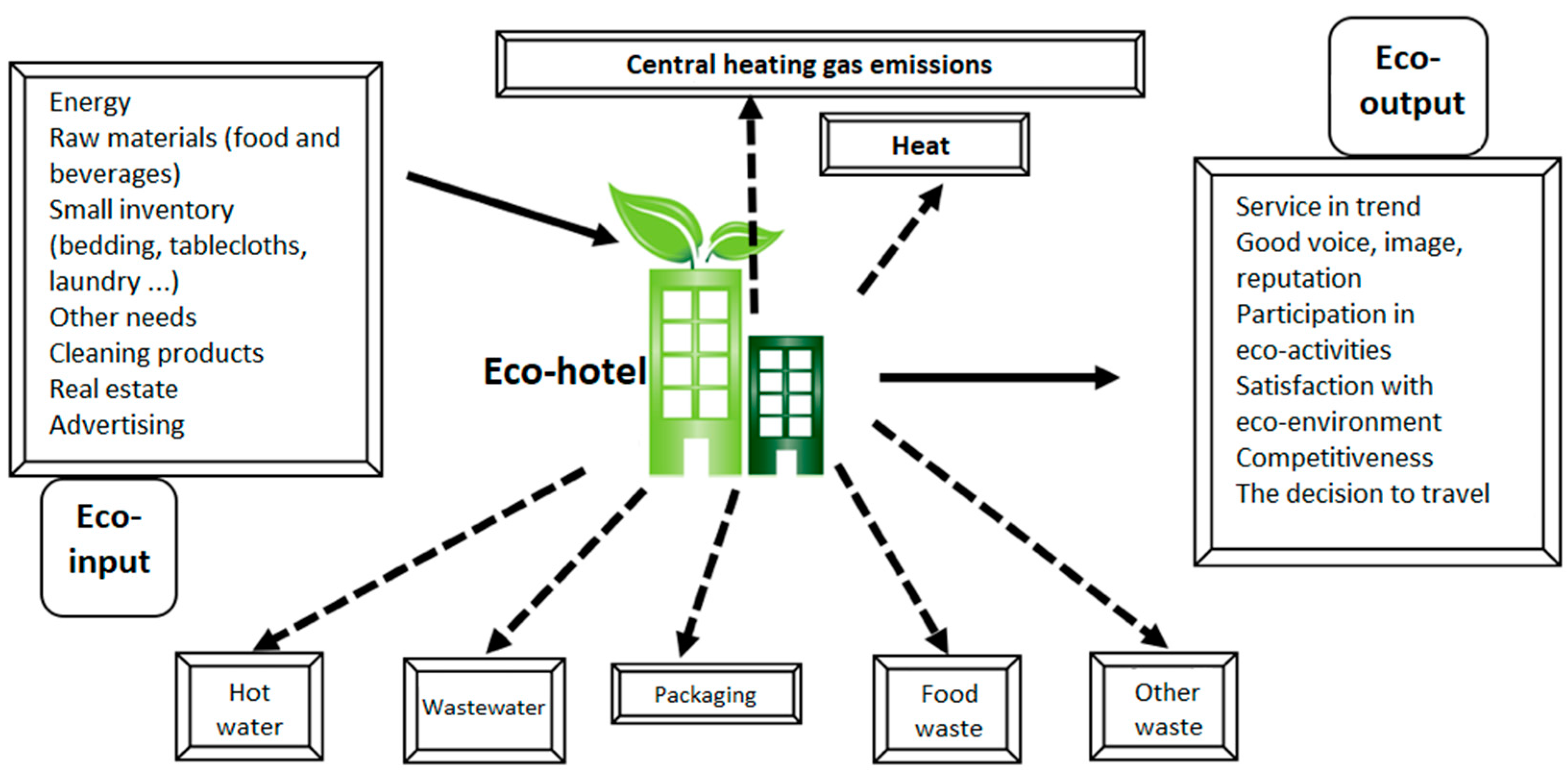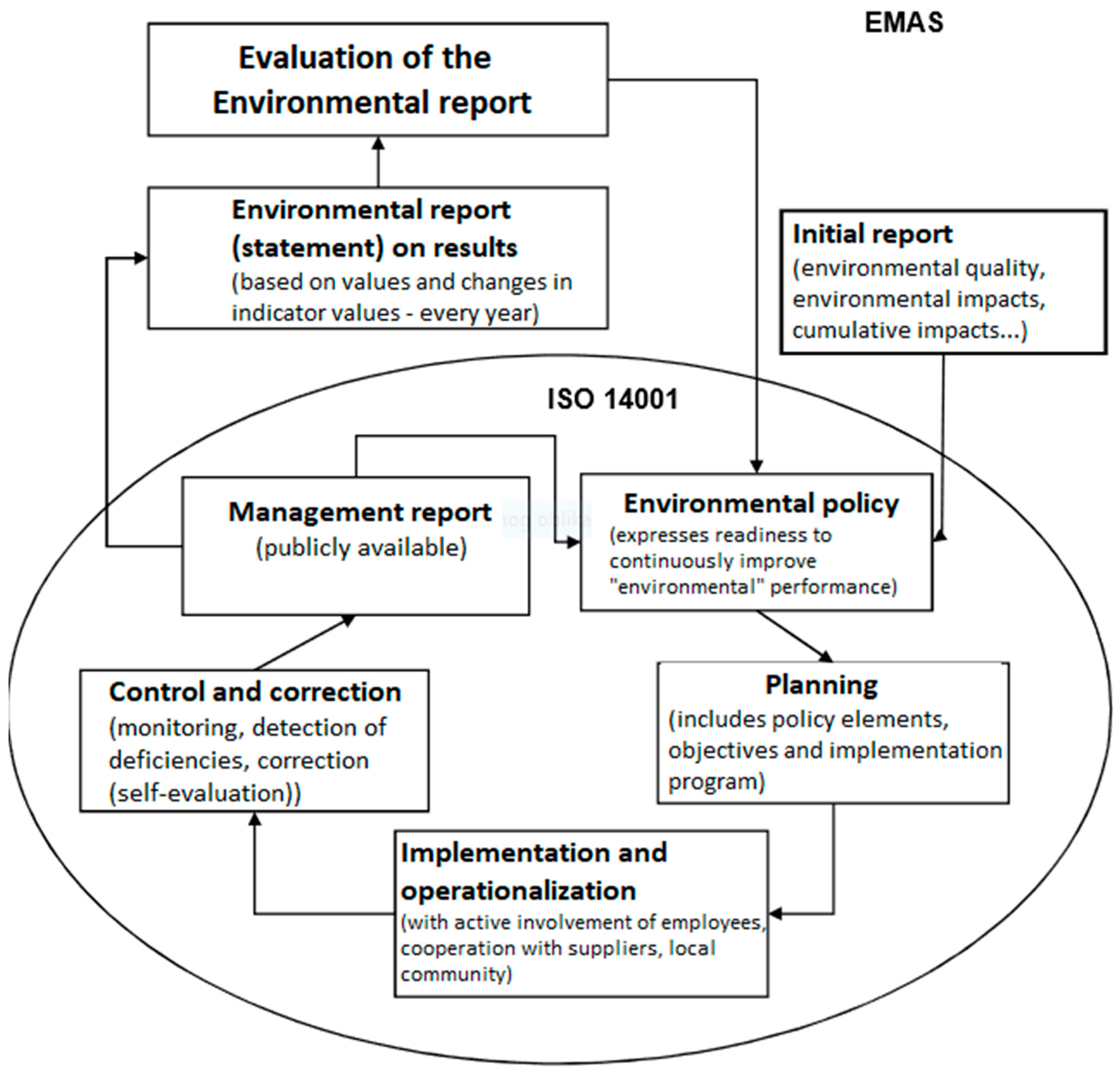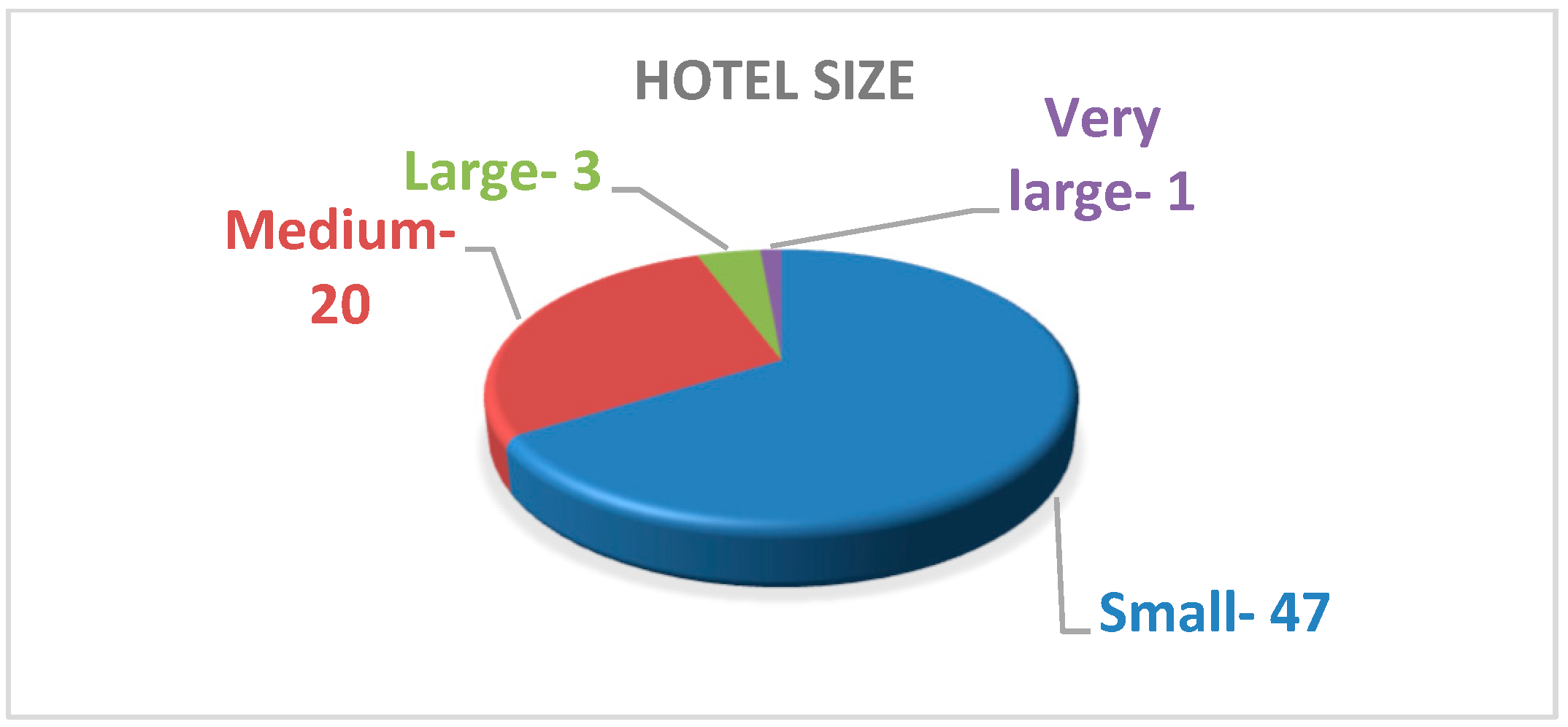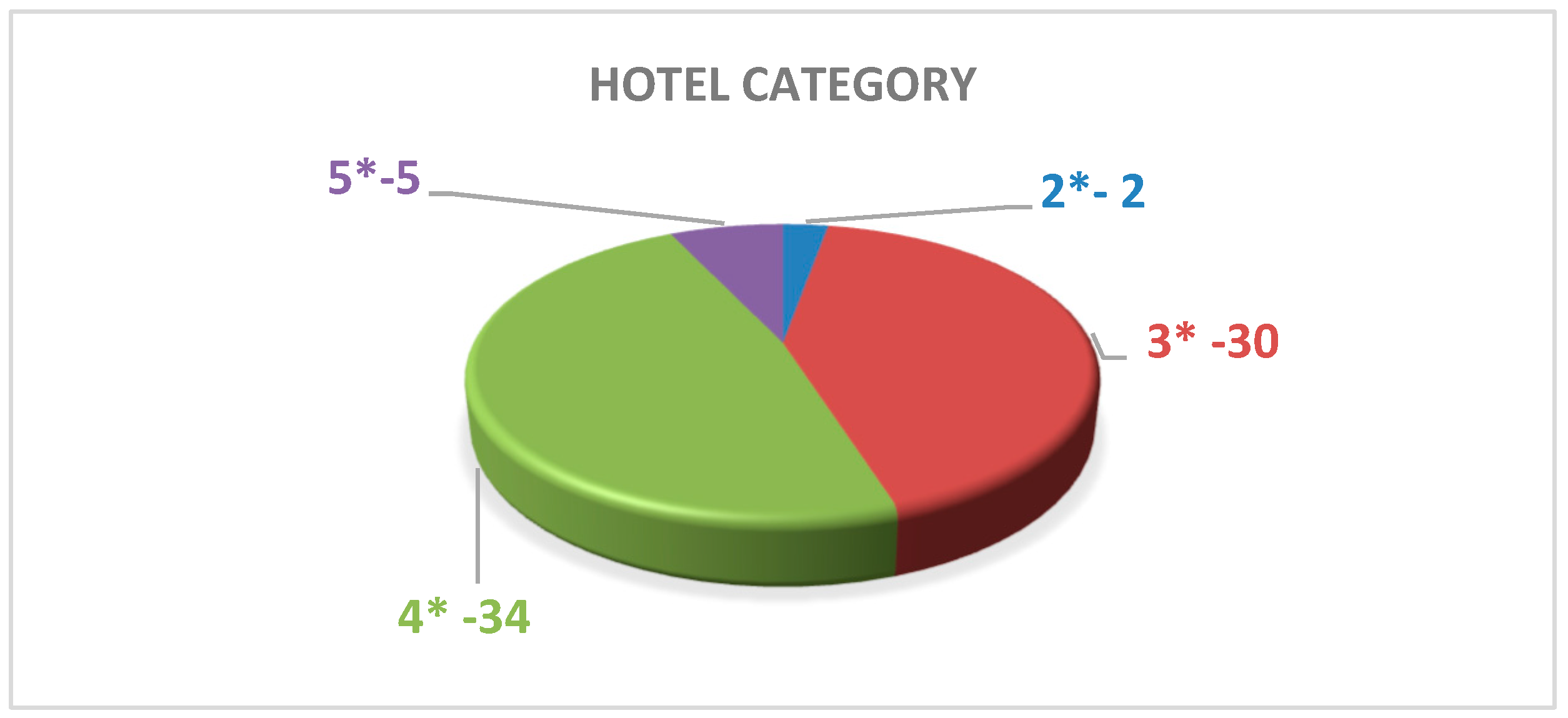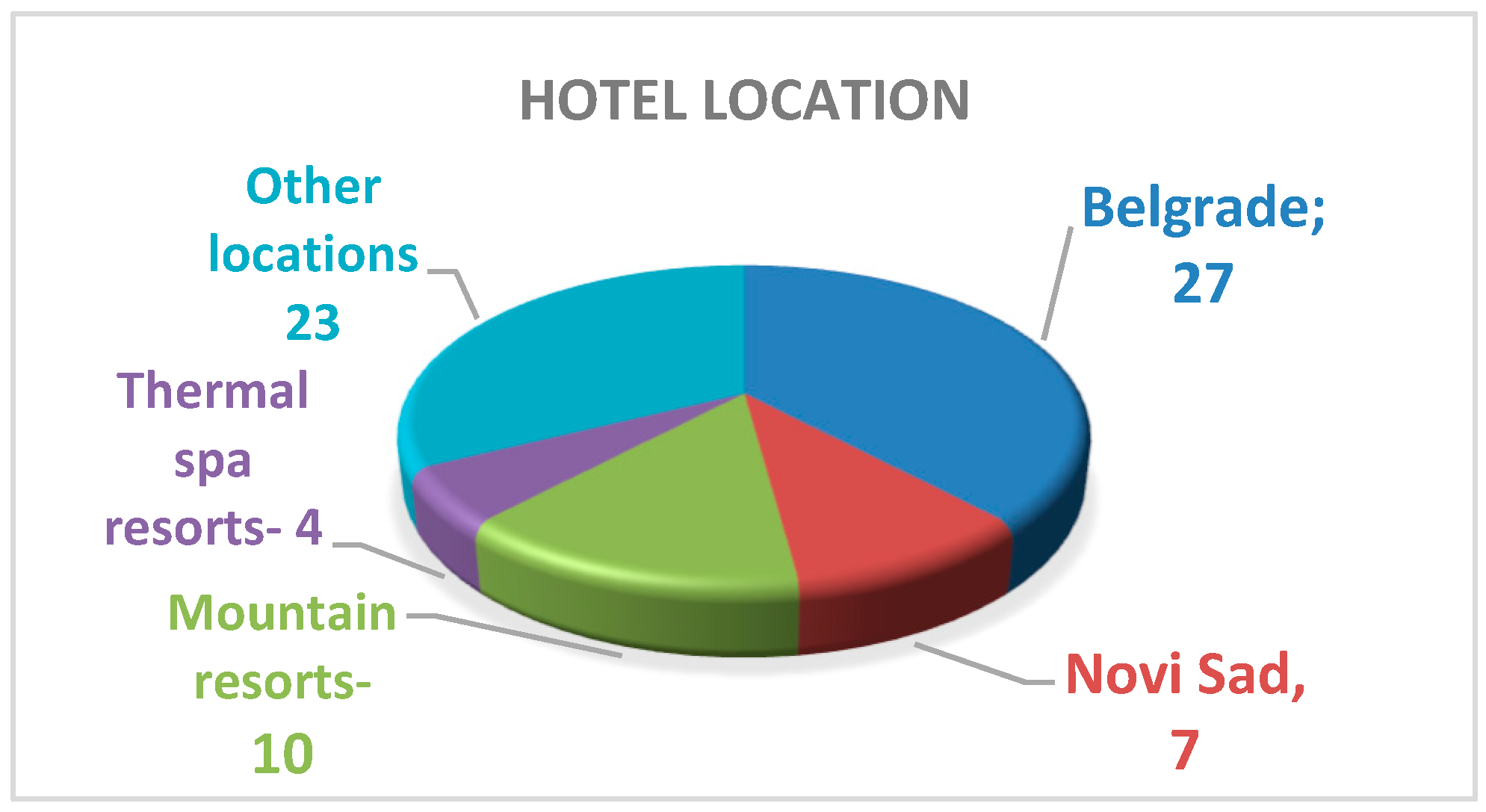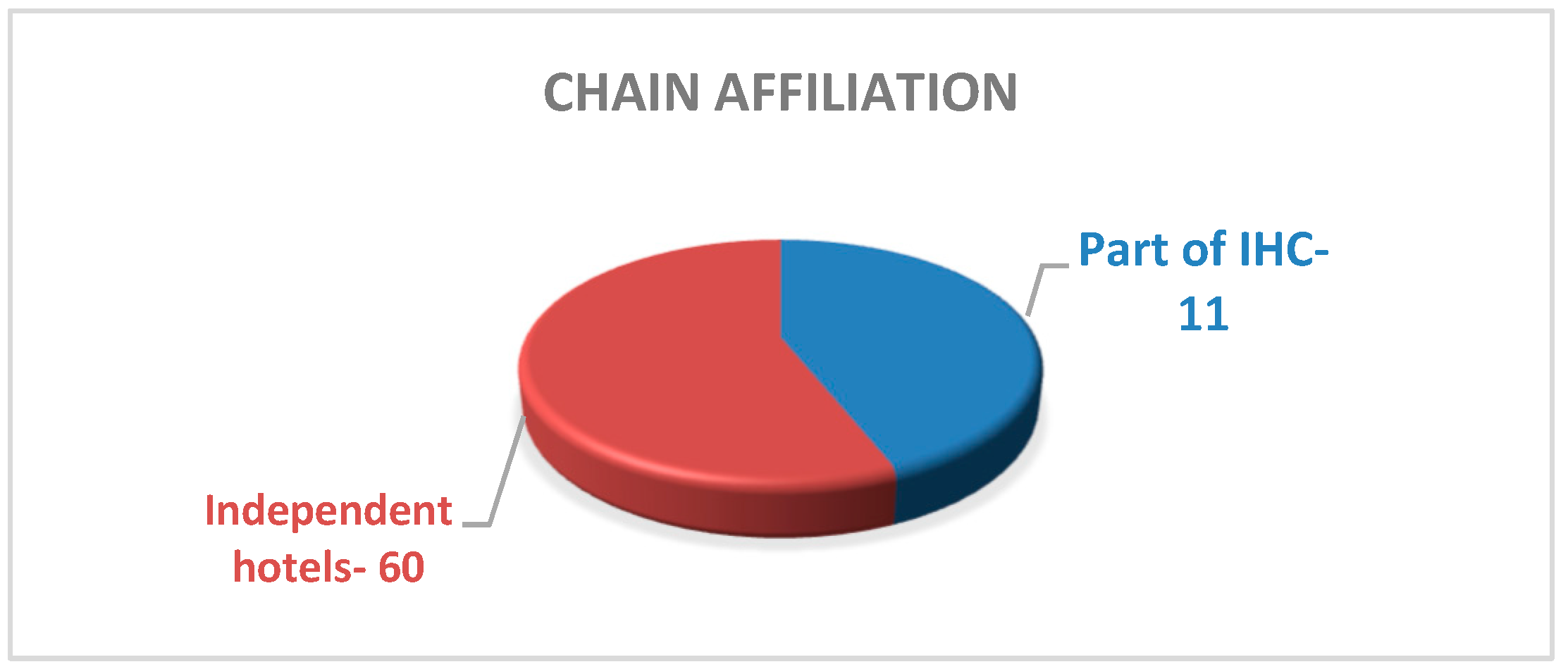2.1. Sustainability of the Hotel Industry
Climate changes require more sustainable tourism goals, among which the saving of resources such as water and energy are particularly outstanding [
20,
21]. Another environmental issue is the greenhouse gas effect. It is estimated that tourism contributes 8% of the greenhouse gas emissions [
22]. Big hotels produce substantial carbon footprints [
23] and, thus, one of the goals of sustainable hotels is to lower the carbon footprint successfully [
24]. There have been quite a few recent contributions on energy and water use in hotels [
20,
23,
25] based on case studies from Austria, Iran and Thailand, but no study has so far covered the sustainability of hotels in Serbia from the aspect of the sustainable hotel business. Therefore, environmental aspects of the hotel business need to be seen as a specific process that requires multidisciplinary analysis. Commitment to these issues also requires an analysis of how to implement environmentally sustainable business successfully in hotels. Studies that analysed the relationship between the environment and hotel performance used different variables, from practice, initiative, technology and environmental management systems to analysis of the specific positive and negative impacts of hotel activities on the environment, as well as emissions [
2,
9,
20,
23,
26,
27,
28,
29,
30,
31,
32,
33,
34]. According to these studies, performance management requires the application of certain elements, instruments, indicators, techniques and methods, on the basis of which managers have the ability to identify, achieve and increase the efficiency of the use of resources and capabilities of the company. Company performance management means managing all company performance at the organisational level, including the performance of the individual (employees). The most important goals and significance of hotel performance management are reflected in improving the performance of resource use and social responsibility of the hotel, continuous development of all employees, as well as meeting the expectations and satisfaction of consumers and all other stakeholders (suppliers, strategic partners, community, etc.) [
8,
34,
35,
36]. In other words, numerous studies have found that there is a positive impact of environmental management on the performance of hotel businesses [
8,
9,
27,
29,
30,
33].
Environmental performance and its significance are based on the hotel’s business strategy, whereby the emphasis is on effects, in order to protect the environment in the long run. These performances form the basis of the corporate responsibility and sustainable business of the hotel company in order to improve the environmental, economic and social performance of the hotel [
37]. In that way, the rational manifestation of sustainability is connected through environmental and social requirements, which contribute to the realisation of positive economic results.
The environmental performance of the company includes the environmental efficiency and effectiveness of all environmental activities and measures applied in the company. Environmental effectiveness represents the achieved environmental effects according to the planned (targeted) environmental measures, programmes, actions and other environmental initiatives. Environmental effectiveness also indicates whether the right choice of environmental measures and activities has been applied in order to improve environmental performance. On the other hand, environmental efficiency represents essentially all the efforts of the company to implement environmental activities and achieve the best environmental effects with as few invested resources as possible. In other words, environmental efficiency represents the achieved environmental effects in relation to investments for the implementation of environmental activities and measures. It seems that this is a well-researched and popular topic across the globe, as it will be presented further on, but at some destinations there is a lack of on the ground knowledge and cooperation between professionals in tourism and academia.
2.2. Performance and Indicators of Hotel Environmental Sustainability
The performance and benefits that hotels achieve by applying environmentally sustainable business have been the subject of research by most authors. These studies have shown that hotels achieve better performance and benefits at all levels, including environmental performance [
1,
8,
9], better financial performance, reduction of costs, especially energetic, greater efficiency of cost control, minimisation of resource use [
5,
26,
32,
38,
39,
40,
41,
42,
43,
44,
45,
46,
47,
48,
49,
50,
51,
52] by introducing environmentally sustainable business.
A large number of authors, in addition to better financial performance, add better competitiveness, corporate image, more effective marketing, increasing brand value, greater trust from tourists, which affect the improvement of all performance and business performance of the hotels significantly [
26,
40,
41,
42,
45,
46,
47,
48,
49,
52,
53,
54,
55], helps better promotion and greater capacity utilisation [
38,
56,
57,
58,
59,
60], which, altogether, contribute to hotels and reaching a leading position in the industry [
55].
Sustainability, which is context specific and ontologically open, is typically interpreted through three pillars: social, economic and environmental [
61,
62]. The goal of sustainable hotel development is reflected in the implementation of long-term sustainable operational business in order to minimise the negative impacts of hotels and protect and preserve the environment and, thus, achieve benefits for the whole community, including economic. Environmental characteristics, such as competitor diversification and organizational characteristics such as size, belonging to a group, star rating and ISO certificate, can have an impact on hotel performance [
4]. The most important benefits of environmentally sustainable hotel business are based on [
63,
64,
65]:
- ▪
Reducing operational costs and cost control efficiency.
- ▪
Additional revenue through lower costs.
- ▪
Greater long-term financial stability.
- ▪
Greater consumer satisfaction.
- ▪
Greater brand reputation and creating a better image (positive PR).
- ▪
Long-term ability to stay in business and be profitable.
- ▪
Reducing negative impacts and preserving the environment.
On the other hand, as already pointed out, the application of environmentally sustainable business also brings financial benefits to all hotels, such as reducing operational costs, especially energy costs due to the high amount of energy consumption and, therefore, costs, their efficient monitoring, more efficient operational business, and so forth [
9,
48,
52].
In order to assess the performance and fulfilment of hotel environmental sustainability indicators, it is necessary to perform an impact assessment of the hotel business on the environment, which includes a hotel condition overview, use of modern technologies, insight and evaluation of the initiatives taken to increase responsibility and environmental protection. In addition, it is necessary to develop a set of measures that will enable continuous monitoring of environmental performance. A large number of authors have researched environmental performance indicators of hotel companies [
66]. Part of these studies dealt with the operational business of hotels, and models of resource use and indicators with an emphasis on the impact of energy and water management on company performance [
28,
29,
67,
68,
69]. Some authors have focused on analysing the environmental performance of hotel energy efficiency, their indicators and reducing CO
2 emissions [
70].
The hotel’s business performance is influenced largely by quality management systems and standards in addressing key environmental issues. To help hotels improve their own approach to environmental protection and promote environmental sustainability, it is possible to use the guidelines of the ISO 14031 Standard to assess activities and performance in the field of Environmental Protection. The utilisation of these tools enables the minimisation of negative effects on the environment, the control of individual environmental impacts, and the easier definition of goals to be achieved through a systematic and strategic approach of environmentally sustainable business. This international Standard does not establish levels of environmental performance, but its purpose is aimed exclusively at improving the company’s approach to Environmental Performance Evaluation (EPE), [
71]. This also includes a devotion to process harmonisation with existing legal and other requirements, pollution prevention and continuous improvement of the hotel’s relationship towards the environment. Within the evaluation of Environmental Performance according to the ISO 14031 Standard, two types of indicators are distinguished [
72]:
- -
Environmental Condition Indicators (ECIs).
- -
Environmental Performance Indicators (EPIs), consisting of Operational Performance Indicators (OPIs) and Management Performance Indicators (MPIs).
When it comes to the results of the implementation of the entire environmental management in the company to be verified, all the above basic groups of indicators (ECIs, OPIs, MPIs) must be taken into account [
71].
Operational Performance Indicators represent the direct impacts of the hotel on the environment and the results achieved by the application of the environmental management system, namely, environmental effects that provide all the relevant information on the environmental performance of the company. This group of indicators refers to indicators showing the consumption of raw materials, energy, water, use of renewable energy sources, emissions of harmful and dangerous substances, waste, and so forth.
Management Performance Indicators show the success of management in the implementation of environmental systems, programmes and activities, the efficiency of system control, division of responsibilities, investments, financial results, employee involvement, safety at work and consumers, internal and external communication, and so forth. In other words, these indicators aim to provide all the necessary information on how the hotel is using specific activities to contribute to the environmental performance of the business.
Indicators of environmental conditions are related to the quality of the environment at the local level and the coverage of global measures and goals of environmental protection, such as reducing resource consumption, greenhouse gas emissions and so forth. These indicators show the quality of the environment in relation to individual elements of the environment such as air, water, land, biodiversity, as well as the extent to which a company affects that quality.
Measuring performance from a hotel perspective is not an easy task. Each hotel, for itself, must, depending on its size, location and business strategy, establish a planning process to identify those environmental aspects and activities that will have a significant impact on the environment, according to the specifics and characteristics of its operational business and environment due to the impact on the environmental performance of the hotel [
49]. Each individual activity can be flexible to the extent to which it is necessary to adjust the business to environmentally sustainable development and the environment in which the hotel is located.
In order to measure performance and environmental sustainability indicators more efficiently, it is necessary to [
72,
73,
74,
75]:
- -
Define the objectives within the environmental management system clearly.
- -
Assess the potential negative impacts of the hotel business on the environment and define measures for their elimination.
- -
Define the criteria and performance that need to be achieved in accordance with the environmentally sustainable business of the hotel.
- -
Report on the achieved goals of environmental sustainability in the business continuously.
Measuring the performance of environmental sustainability should start from predefined indicators such as water consumption, electricity consumption, consumption of cleaning products, number of hotel initiatives to prevent pollution, number of employees participating in environmental protection programmes, costs related to the environmental aspects of the process of implementing environmental protection, the method of waste management, and so forth. On this basis, it is possible to monitor activities that are implemented in the direction of environmental sustainability, and on that basis to enable the commercialisation of the hotel offer, namely, hotel services and products. Following environmental trends, taking into account costs through more efficient consumption of energy, water, waste management and recycling, performance can be tested in hotels, which checks whether everything expected is really achieved on the basis of the defined indicators of environmental impact.
The book “Green to Gold” highlights the way in which the use of different environmental protection strategies can be used in the direction of achieving positive business performance and creating a competitive advantage. The authors Esty and Winston [
76] point out that the gold that hotels and other companies achieve through the application of environmental standards consists of higher revenues, lower operational costs, and often lower interest rates by banks for the introduction of environmental management systems and other environmental measures and programmes.
The performance measurement indicators shown in
Table 1 are supported by empirical research which shows a strong orientation towards economic performance based on profitability, but also a growing need to achieve intangible values, with increasing importance given to educating employees about the importance of the environmental business of the hotel company and the positive impact on the environment, as well as raising awareness, not only among employees, but also among guests [
77].
It should be noted that, for the purpose of applying the indicators, many guides have been published giving instructions on which indicators should be applied in the company and how to collect the necessary data based on these indicators [
73,
78]. The World Tourism Organization has proposed a set of indicators, for example, for energy efficiency, consumption and water quality, referring to the tourist destination, but are also used in tourist companies, including hotels, because they represent an integral part of the destination [
73].
2.3. Factors Influencing the Performance and Choice of Indicators in Hotels
Factors influencing the performance and choice of indicators in hotels can be classified into physical and operational parameters [
79].
Physical parameters are related to the size, structure and hotel building design, geographical location and climatic conditions, age of the building, types of installed energy and water systems, mode of operation of these systems (operational functioning and maintenance), types and quantities of energy used, local water resources available, as well as regulating the use of water and energy at the local level and the prices of these services.
The use of resources in operational business is very specific, because it includes the work and work schedule of different hotel departments within the facility. These include a number of facilities used in hotels (restaurants, kitchens, laundry, swimming pools, Sports and Business Centre, Spa, etc.), types of services provided, fluctuations in capacity utilisation, variations in guest comfort requirements, practice of management and conservation of water and energy in the environment, the need for irrigation of green areas, the awareness of guests and employees about the need to reduce the use of resources. Some of these indicators are difficult to measure or quantify, especially when it comes to the level of awareness of service users and employees about the importance of environmental protection, because they represent qualitative parameters. The most important aspects of environmental management in hotels are focused on the environmental performance of the space, resources and products and services provided by the hotel. From a spatial point of view, the hotel can be divided into three zones [
80,
81,
82]:
- ▪
Guest area (hotel rooms)
- ▪
Public area (reception, lobbies, halls, bars, restaurants, swimming pools, saunas, and so forth, technical equipment and size of the space, the average number of people using the space and services, etc.)
- ▪
Service area (kitchen, offices, warehouses, laundry, locker rooms, canteen for employees, the technical department where heating, ventilation, cooling and other systems are located, etc.).
It should be emphasised that the differences in the use of resources are large in the zones and departments of the hotel, but also by the work schedule, that is, the time of use of resources during 24 h.
Given the importance of sustainability and its impact on business performance, hotel companies today focus on environmental sustainability activities related to the rational use of resources (energy, water, food) and environmental impact management, including waste. Directing hotel activities in order to improve their performance in the field of environmental protection must be based primarily on the rational use of all resources and the efficient management of generated waste [
41].
Energy efficiency is being set as the primary factor that determines the performance of a hotel business due to high energy consumption and costs [
38,
48,
62]. Discussions in research in this area indicate the need to pay more attention to the use of energy savings in the direction of achieving better hotel business performance. This is further evidenced by the growing demands of tourists on the need for environmentally conscious hotel behaviour through energy savings, and the provision of a full range of environmentally friendly services and products [
83].
The traditional concept of measuring annually per square meter of hotel space is applied to measure energy consumption. However, this indicator needs to be adjusted, depending on variations in weather conditions and their impact on energy consumption [
84]:
It is necessary to point out once again that energy consumption depends on physical parameters such as the size of the facility, structure and design, the geographical area in which the hotel is located and the type of energy used for the needs of the hotel business. For example, the energy consumption for heating in hotels depends on the outside air temperature, and the energy consumption for water heating depends on the number of guests. In addition, it should be noted that the volume of energy consumption is influenced by the number of departments and service segments of the hotel (kitchen, laundry, Sports Centre, Spa, etc.).
Bearing in mind that it is marked as a key aspect, the potential of energy use in hotels should be focused on the implementation of an appropriate strategy to achieve greater energy efficiency, which contributes to achieving positive business performance, and which is best illustrated by research and practical examples. IHG, for example, implements energy efficiency through an advanced Green Engage system, which contributes to increasing the environmental performance of hotels, that is, savings in energy consumption, but also to taking additional measures to achieve even greater efficiency [
56,
85].
In a study conducted among hotels and hotel chains in Greece, the results showed that 72–75% of total energy consumption is used for air conditioning (cooling and heating), for the production of hot water 8–9%, while for lighting about 15% is used [
86].
A significant issue affecting hotel performance also relates to the consumption and management of water resources. When it comes to water consumption, the following standard formula can be used to calculate it [
84]:
Taking specific measures, such as installing faucets and toilets with reduced water consumption, constant control and inspection of the water supply network, use of the so-called grey water, can help reduce water consumption significantly.
It should be noted that the usual (harmonised) units of measure used to measure the most important indicators of environmental performance, as well as for comparison (benchmarking), are the following [
43]:
- ▪
Energy in kilowatts per hour (kWh);
- ▪
Water in litres (L), (total consumption, m3/year);
- ▪
Floor area in square metres (m2);
- ▪
Carbon dioxide emissions in kilograms (kgCO2e), (only carbon dioxide, methane and nitrate oxide are used).
In order to be able to quantify as clearly as possible the most commonly used environmental indicators are used, which represent the resources consumed (input) per unit and the material results achieved in the process of production and provision of services (output) in the company. Two groups of target functions in a tourism company, inputs and outputs, need to be defined in the Development Policy. Outputs refer to the growth of economic categories (revenue, profit, employment, etc.), while inputs express use, that is, resource consumption.
For the hotel industry, the basic indicators are guests per night (rooms sold), the number of rooms occupied, and cover charges sold in hotel restaurants are often used [
73,
87]. To calculate the total utilisation of resources in the hotel, it is necessary to calculate and divide all inputs of consumed resources per unit with the total output of the provided service in the hotel per time unit, that is, all achieved material results, as shown in the formula below [
48]:
The time unit can be used on a monthly, quarterly and annual basis. The total output of the service provided includes the number of occupied rooms, the number of guests served in the hotel, the number of cover charges sold in restaurants, and more. Inputs involve calculating resource consumption by type and unit, such as energy and water consumption according to the aforementioned or other similar formulas, which are then summed to obtain the total resource consumption.
Figure 1 shows an example of environmental inputs and outputs in hotel business activities and operational business processes that affect environmental pollution, as well as those activities that the hotel needs to carry out in order to become an environmentally sustainable hotel.
2.4. Performance Evaluation and Reports
Performance evaluation is an assessment of the indicators and methods used in measuring the environmental performance of a hotel company [
1]. Performance evaluation is also important for the preparation of reports, that is, reporting on environmental performance. In order to standardise environmental reports as much as possible at the global level, UNEP has made a recommendation that contains five main grouped areas important for environmental reporting, which are [
86]:
- ▪
Management (company data, environmental policy, goals and development, environmental management system, etc.);
- ▪
Analysis of inputs/outputs (resources, energy, wastewater, materials, environmental risk, waste, air pollution, etc.);
- ▪
Finances (all financial indicators, realised savings, investments, etc.);
- ▪
Stakeholder requirements (consumers, employees, business partners, investors, local community, media, science, education, etc.);
- ▪
Global measures and goals (response to set global goals and measures, respect for the needs of balanced development, respect for Standards, cooperation, etc.).
According to the ISO 14031 Standard, environmental reporting means providing relevant information on environmental protection and company performance in order to meet the requirements of various stakeholders at the tourist destination level, which are very important for business because they create greater public trust and, thus, help a more successful appearance in a market, particularly the global market. The requirements of various stakeholders relate to investors and shareholders, banks, insurance companies, regulatory bodies, government institutions, local governments, consumers, business partners, employees, NGOs and media [
72]. In the process of environmental reporting itself, it is necessary to take into account Standards, policies, norms, criteria and different levels of hotel operations in order for reporting to be adequate. Environmental reporting according to the EMAS Standards is certainly a relevant and complex reporting system of integrated environmental management that meets the Standards and norms of environmental reporting according to world standards.
Figure 2 shows the system of reporting of integrated environmental management according to the EMAS Standards.
It should be noted that EMAS, or EMS, Eco Management Systems, represent an entire and complete system of management, planning and control of environmental protection in hotels [
2,
31,
90,
91,
92,
93,
94,
95], but hotels still implement the ISO 14001 Standard more than EMAS/EMS, primarily because the costs of implementing ISO 14001 are lower in regard to EMAS/EMS [
41].
The subject of research by many authors is also performance indicators, that have been used and published to compare the environmental performance of hotel companies (benchmarking), but also for the debate, due to the large variation in reports [
27,
69,
96]. This is due to the different methodologies used in data collection, as well as the characteristics they take as references for measurement (e.g., weather conditions, types of hotel services and equipment, capacity utilisation level, building size) by benchmarking organisations or economic entities. The application of benchmarking has indicated that it is impossible to establish unique environmental performance model for all hotels, but different approaches to benchmarking modelling can be developed that can include a strategy to increase environmental performance [
30]. There are also special programmes designed for environmental reporting, as well as planning management strategies and investments in the field of Environmental Protection in hotels, especially energy [
97].
It should be noted that the requirements related to the transparency of environmental performance and CSR reporting are very large and include a large amount of data related to one hotel, and are related mostly to resource use, emissions and waste. It should be emphasised once again that there is no unique methodology in measuring, collecting and verifying the collected data.
Some hotels, especially hotel chains, use the world-renowned GRI (Global Reporting Initiative) indicators, that is, the GRI Index for economic, environmental and social aspects of business performance in their reports [
85,
98]. GRI Environmental Standards apply to: GRI 301: Materials 2016, GRI 302: Energy 2016, GRI 303: Water and Effluents 2018, GRI 304: Biodiversity 2016, GRI 305: Emissions 2016, GRI 306: Waste 2020, GRI 307: Environmental Compliance 2016, GRI 308: Supplier Environmental Assessment 2016, [
99].
Some hotels that have eco-labels (certificates) base their reports on the requirements of these eco-labels. Each eco-label has basic and specific indicators and criteria, and the certification process itself includes several stages, including control, which includes the preparation of reports. This refers to the most famous and recognised eco-labels on a global level, which are accepted in the world, and which are important and relevant for hotels, such as: Green Globe, Green Seal, Green Leaf, Ecotel [
100,
101]. It should be emphasised that obtaining an eco-label means that hotels belong to a group of hotels that consume resources rationally and treat the environment responsibly and manage environmental business performance.
For example, The Hilton Group conducts its environmental reporting and benchmarking through the HER system (Hilton Environmental Reporting) for its hotels around the world, which it has developed itself to help its hotels track resource use and variations over time. HER is available on the Hilton intranet using two levels of reporting and three separate forms that each hotel must complete [
102]: (1) Hotel profile; (2) Environmental data and (3) Energy consumption data.
It is also necessary to mention the reporting scheme and benchmarking of the Green Globes Canada, which is used to compare the environmental performance of constructions (buildings) with objects of similar characteristics contained in the database, including the assessment of the performance of hotel facilities. The audit criteria are based on the internationally accepted Environmental assessment methods for building (BREEAM), [
102].
The assessment questionnaire is divided into 7 modules, and requires the following information to be entered [
102]: (1) Information on the building; (2) Energy: Energy consumption; (3) Water: Water consumption; (4) Resources: Waste reduction and recycling; (5) Emissions: Air emissions; (6) Indoor environment: Indoor air; (7) Environmental management: EMS documentation.
On average, there are about 75 questions that require simple answers, but the questions related to resource consumption require the entry of monthly data for a period of 12 months (which is specified), so the questionnaire can be completed in 2 to 3 h [
102].
From the above examples, it can be seen that the complexity of the manner and methodology of collection and benchmarking of reporting is very large and requires a detailed collection of a numerous amount of relevant information, that is, indicators of the environmental performance of the company.
Some research indicates that many hotels do not have reports on environmentally sustainable business, which means that they do not apply enough, or do not apply environmental business in their hotels at all, and are not aware of the importance of environmental performance which can contribute greatly to reducing their costs, as well as reducing the negative impact on the environment, but also has many other benefits. An analysis of five indicators related to the perception of energy efficiency in hotels in southern Europe (activities related to environmental protection, solid waste management, efficient use of resources, benefits and constraints) found that most of these hotels do not have Environmental Reports [
103]. It should be emphasised that, on the other hand, Environmental Performance Reports provide an insight into environmental commitment, and help hotels in implementing additional activities to reduce resource consumption further, and, thus, costs, which means that they can improve their business further in the future.
